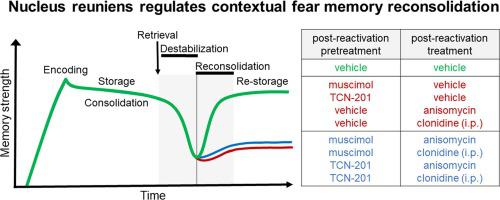Neurobiology of Learning and Memory ( IF 2.2 ) Pub Date : 2020-11-23 , DOI: 10.1016/j.nlm.2020.107343 Fernanda Troyner 1 , Leandro Jose Bertoglio 1

|
The nucleus reuniens has been shown to support the acquisition, consolidation, maintenance, destabilization upon retrieval, and extinction of aversive memories. However, the direct participation of this thalamic subregion in memory reconsolidation is yet to be examined. The present study addressed this question in contextually fear-conditioned rats. Post-reactivation infusion of the GABAA receptor agonist muscimol, the glutamate N2A-containing NMDA receptor antagonist TCN-201, or the protein synthesis inhibitor anisomycin into the NR induced significant impairments in memory reconsolidation. Administering muscimol or TCN-201 and anisomycin locally, or associating locally infused muscimol or TCN-201 with systemically administered clonidine, an α2-receptor adrenergic agonist that attenuates the noradrenergic tonus associated with memory reconsolidation, produced no further reduction in freezing times when compared with the muscimol-vehicle, TCN-201-vehicle, vehicle-anisomycin, and vehicle-clonidine groups. This pattern of results indicates that such treatment combinations produced no additive/synergistic effects on reconsolidation. It is plausible that NR inactivation and antagonism of glutamate N2A-containing NMDA receptors weakened/prevented the subsequent action of anisomycin and clonidine because they disrupted the early stages of signal transduction pathways involved in memory reconsolidation. It is noteworthy that these pharmacological interventions, either alone or combined, induced no contextual memory specificity changes, as assessed in a later test in a novel and unpaired context. Besides, omitting memory reactivation precluded the impairing effects of muscimol, TCN-201, anisomycin, and clonidine on reconsolidation. Together, the present findings demonstrate interacting mechanisms through which the NR can regulate contextual fear memory restabilization.
中文翻译:

丘脑团聚核控制恐惧记忆再巩固
核团聚已被证明支持获取、巩固、维持、检索时的不稳定和厌恶记忆的消失。然而,这个丘脑亚区是否直接参与记忆再巩固还有待研究。本研究在情境恐惧条件下的大鼠中解决了这个问题。将 GABA A受体激动剂 muscimol、含谷氨酸 N2A 的 NMDA 受体拮抗剂 TCN-201 或蛋白质合成抑制剂茴香霉素再激活后输注到 NR 中,会导致记忆再巩固显着受损。局部给药 muscimol 或 TCN-201 和茴香霉素,或将局部输注的 muscimol 或 TCN-201 与全身给药的可乐定、α 2β-受体肾上腺素能激动剂减弱与记忆再巩固相关的去甲肾上腺素能紧张,与 muscimol 载体、TCN-201-载体、载体-茴香霉素和载体-可乐定组相比,冻结时间没有进一步减少。这种结果模式表明,这种处理组合对再固结没有产生附加/协同效应。NR 失活和对含谷氨酸 N2A 的 NMDA 受体的拮抗作用减弱/阻止了茴香霉素和可乐定的后续作用是合理的,因为它们破坏了参与记忆再巩固的信号转导途径的早期阶段。值得注意的是,这些药理干预,无论是单独的还是组合的,都不会引起上下文记忆特异性的变化,正如后来在新的和未配对的上下文中的测试所评估的那样。此外,省略记忆再激活排除了 muscimol、TCN-201、茴香霉素和可乐定对再巩固的损害作用。总之,目前的研究结果表明,NR 可以通过交互机制来调节情境恐惧记忆的重新稳定。











































 京公网安备 11010802027423号
京公网安备 11010802027423号